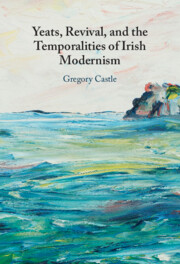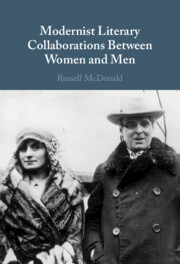27 results

Yeats, Revival, and the Temporalities of Irish Modernism
-
- Published online:
- 11 April 2024
- Print publication:
- 18 April 2024
Chapter 7 - W. B. Yeats, the Irish Free State, and the Rhetoric of Race Suicide
-
-
- Book:
- Race in Irish Literature and Culture
- Published online:
- 04 January 2024
- Print publication:
- 18 January 2024, pp 143-171
-
- Chapter
- Export citation
Chapter 6 - Modernist
- from Part I - Literary Periods
-
-
- Book:
- The Cambridge Companion to Literature and Animals
- Published online:
- 26 October 2023
- Print publication:
- 09 November 2023, pp 112-131
-
- Chapter
- Export citation
6 - Centrism
- from PART III - DO MODERATES HAVE A POLITICAL VISION?
-
- Book:
- Why Not Moderation?
- Published online:
- 12 October 2023
- Print publication:
- 12 October 2023, pp 118-126
-
- Chapter
- Export citation
Chapter 4 - Technologies of Sound: Telephone/Gramophone
- from Part I - Genealogies
-
-
- Book:
- Technology in Irish Literature and Culture
- Published online:
- 19 January 2023
- Print publication:
- 26 January 2023, pp 65-80
-
- Chapter
- Export citation
Chapter 11 - Ireland
- from Part II - Nations and Voices
-
-
- Book:
- A History of World War One Poetry
- Published online:
- 18 January 2023
- Print publication:
- 12 January 2023, pp 182-199
-
- Chapter
- Export citation
Chapter 9 - Irish Nationalism
- from Part II - 1945–1989: New Nations and New Frontiers
-
-
- Book:
- The Cambridge Companion to Twentieth-Century Literature and Politics
- Published online:
- 01 December 2022
- Print publication:
- 15 December 2022, pp 150-164
-
- Chapter
- Export citation
Chapter 5 - Conclusion: Being a Genius Together
-
- Book:
- Modernist Literary Collaborations between Women and Men
- Published online:
- 20 October 2022
- Print publication:
- 27 October 2022, pp 205-223
-
- Chapter
- Export citation
Chapter 4 - “The Yolk and White of the One Shell”: Modernism’s Androgynous Textual Bodies
-
- Book:
- Modernist Literary Collaborations between Women and Men
- Published online:
- 20 October 2022
- Print publication:
- 27 October 2022, pp 160-204
-
- Chapter
- Export citation
Chapter 3 - “The Fight to Be Affectionate”: Textual Intimacy and the Drive to Animate Marriage
-
- Book:
- Modernist Literary Collaborations between Women and Men
- Published online:
- 20 October 2022
- Print publication:
- 27 October 2022, pp 103-159
-
- Chapter
- Export citation

Modernist Literary Collaborations between Women and Men
-
- Published online:
- 20 October 2022
- Print publication:
- 27 October 2022
Chapter 13 - Poetry and Transition
- from Part III - Aesthetics
-
-
- Book:
- British Literature in Transition, 1900–1920: A New Age?
- Published online:
- 07 December 2021
- Print publication:
- 02 December 2021, pp 244-259
-
- Chapter
- Export citation
Chapter 12 - Transitions, Turns
- from Part III - Aesthetics
-
-
- Book:
- British Literature in Transition, 1900–1920: A New Age?
- Published online:
- 07 December 2021
- Print publication:
- 02 December 2021, pp 229-243
-
- Chapter
- Export citation
Chapter Two - Between Byzantium and Beijing
-
- Book:
- The Irish Expatriate Novel in Late Capitalist Globalization
- Published online:
- 29 October 2021
- Print publication:
- 11 November 2021, pp 84-130
-
- Chapter
- Export citation
Chapter 5 - Spaces and Objects
-
- Book:
- Yeats on Theatre
- Published online:
- 09 July 2021
- Print publication:
- 29 July 2021, pp 113-142
-
- Chapter
- Export citation
Chapter 2 - The Fugitive Organum
-
- Book:
- Yeats on Theatre
- Published online:
- 09 July 2021
- Print publication:
- 29 July 2021, pp 43-64
-
- Chapter
- Export citation
Chapter 6 - Bodies and Voices
-
- Book:
- Yeats on Theatre
- Published online:
- 09 July 2021
- Print publication:
- 29 July 2021, pp 143-170
-
- Chapter
- Export citation
Chapter 4 - Form
-
- Book:
- Yeats on Theatre
- Published online:
- 09 July 2021
- Print publication:
- 29 July 2021, pp 93-112
-
- Chapter
- Export citation
Chapter 1 - The Playwright as Thinker
-
- Book:
- Yeats on Theatre
- Published online:
- 09 July 2021
- Print publication:
- 29 July 2021, pp 15-42
-
- Chapter
- Export citation
Chapter 3 - Tragedy and Comedy
-
- Book:
- Yeats on Theatre
- Published online:
- 09 July 2021
- Print publication:
- 29 July 2021, pp 65-92
-
- Chapter
- Export citation



